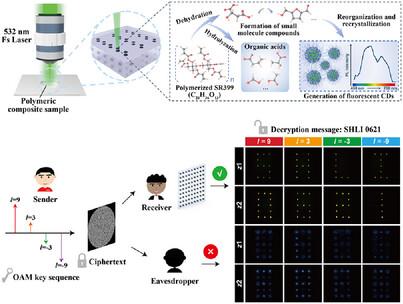Direct Laser Writing 3D Carbon Dot Array for Orbital Angular Momentum Holographic Encryption
IF 10
1区 物理与天体物理
Q1 OPTICS
引用次数: 0
Abstract
Information security is crucial in modern society, spawning numerous cryptographic strategies to protect data from stealing and deciphering. Among them, optical encryption is an excellent candidate due to its unique features such as high‐speed parallel processing, low power consumption, and abundant degree of freedom. Despite recent advances of nanophotonic devices that have promoted the development of optical encryption techniques, the realization of high‐security and high‐capacity all‐optical 3D image encryption remains an ongoing challenge due to the absence of a suitable 3D nanophotonic device. Here, the study constructs an integrated 3D carbon dot (CD) array through direct laser writing (DLW) in a solid‐state polymeric material and demonstrate its parallel manipulation and selective transmission characteristics of multiple orbital angular momentum (OAM) beams. Benefitting from the photo‐luminescence responses of the CDs and theoretically unlimited helical mode indices of OAM beams, a high‐security and high‐capacity all‐optical encryption platform by integrating the 3D CD array and an OAM‐multiplexing hologram is developed. Through the platform, the encryption and decryption of a series of multi‐plane 3D images can be realized without additional digital post‐processing. The results provide a novel inspiration for nanophotonic devices‐based all‐optical encryption and advance the development of optical encryption applications harnessing light's OAM dimension.

用于轨道角动量全息加密的直接激光写入三维碳点阵列
信息安全在现代社会中至关重要,产生了许多加密策略来保护数据不被窃取和破译。其中,光加密由于其高速并行处理、低功耗和丰富的自由度等独特特性而成为一个优秀的候选者。尽管纳米光子器件的最新进展促进了光学加密技术的发展,但由于缺乏合适的3D纳米光子器件,实现高安全性和高容量的全光学3D图像加密仍然是一个持续的挑战。本研究通过直接激光写入(DLW)技术在固态聚合物材料上构建了一个集成的三维碳点(CD)阵列,并展示了其平行操纵和多轨道角动量(OAM)光束的选择性传输特性。利用CD的光致发光响应和理论上无限的OAM光束螺旋模指数,将3D CD阵列和OAM复用全息图集成在一起,开发了一个高安全性、高容量的全光加密平台。通过该平台,可以实现一系列多平面三维图像的加解密,而无需额外的数字后处理。该结果为基于纳米光子器件的全光加密提供了新的灵感,并推动了利用光的OAM维度的光加密应用的发展。
本文章由计算机程序翻译,如有差异,请以英文原文为准。
求助全文
约1分钟内获得全文
求助全文
来源期刊
CiteScore
14.20
自引率
5.50%
发文量
314
审稿时长
2 months
期刊介绍:
Laser & Photonics Reviews is a reputable journal that publishes high-quality Reviews, original Research Articles, and Perspectives in the field of photonics and optics. It covers both theoretical and experimental aspects, including recent groundbreaking research, specific advancements, and innovative applications.
As evidence of its impact and recognition, Laser & Photonics Reviews boasts a remarkable 2022 Impact Factor of 11.0, according to the Journal Citation Reports from Clarivate Analytics (2023). Moreover, it holds impressive rankings in the InCites Journal Citation Reports: in 2021, it was ranked 6th out of 101 in the field of Optics, 15th out of 161 in Applied Physics, and 12th out of 69 in Condensed Matter Physics.
The journal uses the ISSN numbers 1863-8880 for print and 1863-8899 for online publications.

 求助内容:
求助内容: 应助结果提醒方式:
应助结果提醒方式:


